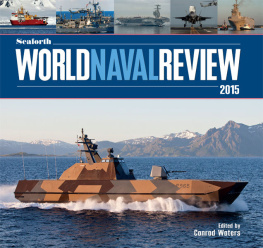Frontispiece: The new British aircraft carrier Queen Elizabeth pictured on 30 June 2017, shortly after her 26 June departure from Rosyth on initial sea trials. She will be the largest warship ever to serve with the Royal Navy when delivered towards the end of 2017. The US Navy also took delivery of its own largest-ever warship, the aircraft carrier Gerald R. Ford (CVN-78) in 2017. (Crown Copyright 2017)
Copyright Seaforth Publishing 2017
Plans John Jordan 2017
First published in Great Britain in 2017 by
Seaforth Publishing
An imprint of Pen & Sword Books Ltd
47 Church Street, Barnsley
S Yorkshire S70 2AS
www.seaforthpublishing.com
Email
British Library Cataloguing in Publication Data
A CIP data record for this book is available from the British Library
ISBN 978 1 5267 2009 2 (Hardback)
ISBN 978 1 5267 2010 8 (Kindle)
ISBN 978 1 5267 2011 5 (ePub)
All rights reserved. No part of this publication may be reproduced or transmitted in any form or by any means, electronic or mechanical, including photocopying, recording, or any information storage and retrieval system, without prior permission in writing of both the copyright owner and the above publisher.
The right of Conrad Waters to be identified as the author of this work has been asserted in accordance with the Copyright, Designs and Patents Act 1988
Note on Tables: Tables are provided to give a broad indication of fleet sizes and other key information but should be regarded only as a general guide. For example, many published sources differ significantly on the principal particulars of ships, whilst even governmental information can be subject to contradiction. In general terms, the data contained in these tables is based on official information updated as of June 2017, supplemented by reference to a wide range of secondary and corporate sources, such as shipbuilder websites.
OVERVIEW
INTRODUCTION
I n these matters the only certainty is that nothing is certain wrote Pliny the Elder (AD 23AD 79), the Roman officer, fleet commander and author who was to meet an untimely death during the eruption of Vesuvius. The seemingly improbable series of events that have marked the last twelve months bear witness to the truth of this observation. The United Kingdoms vote to leave the European Union (the so-called Brexit), the election of Donald Trump to the American presidency and the emergence of Emmanuel Macron as Frances new, progressive leader are just some of the milestones that mark a turbulent and unsettled year.
Information from the Stockholm International Peace Research Institute (SIPRI) https://www.sipri.org/databases/milex/ The SIPRI Military Expenditure Database contains military expenditure data on countries over the period 19492016.
Notes:
Spending figures are at current prices and market exchange rates.
Figures for China Saudi Arabia and the UAE are estimates, with the UAE figures relating to 2014.
Data on military expenditure as a share of GDP (Gross Domestic Product) relates to 2016 GDP estimates from the IMF World Economic Outlook and International Financial Statistics database, October 2016.
Change is real terms change, ie adjusted for local inflation.
Figures in brackets reflect rank in 2015, revised for latest information.
These political developments will inevitably feed through to defence and naval policy. The impact of the new Trump administration in the United States is likely to be the most marked. At one level, the advent of a new administration is apparently being accompanied by a more robust approach to defence spending that has been significantly constrained in recent years by the financial curbs imposed by the 2011 Budget Control Act (BCA). The FY2018 budget request from the US Department of Defense amounts to a total of US$639bn. This is over five percent higher than the previous years authorisation and includes a base budget set some US$52bn above the BCA cap. However, uncertainties remain. The Trump presidency has yet to translate its campaign promises on defence including an enlarged, 350-ship navy into a clear defence strategy. This will only emerge over the next year. It is also unclear to what extent President Trumps rhetoric will be matched by reality. Notably, if a military build-up is to be achieved, an accommodation will need to be reached with the fiscally conservative Republicans who could block spending proposals in Congress.
The new Trump presidency is also significant in terms of its implications for the United States relations with its global network of alliances. In addition to the inevitable tensions resulting from the Presidents penchant for Twitter diplomacy, a more enduring theme has been his emphasis on a nationalistic America First Foreign Policy. This seemingly views trade agreements and many other forms of international collaboration as a burden. A particular bte noir for the new administration is their view that many of Americas allies are not paying their fair share of the costs associated with collective security arrangements, such as NATO.
Some of the difficulties already inherent in maintaining US global influence have been revealed by developments in South East Asia over the past twelve months. Although Chinas expansionist ambitions in the region received a setback on 12 July 2016 when the Permanent Court of Arbitration in The Hague determined that its claims over much of the South China Sea had no legal basis, an ongoing economic and diplomatic offensive has negated much of the rulings impact. Notably, a Chinese rapprochement with new Philippine president Rodrigo Duterte have done much to negate previous American efforts to build a network of regional alliances to counter Chinas claims. The sustained rise in Chinese military spending and capability seen in recent years have already resulted it being regarded as a near-peer US competitor. However, there are some signs that the economic growth that has spurred Chinas defence expenditure is now slowing as the country starts to reach maturity.
For the time being, the most recent available information for global defence spending is captured by A marked reduction in the British total arose from the severe depreciation of sterling after the Brexit vote.
















